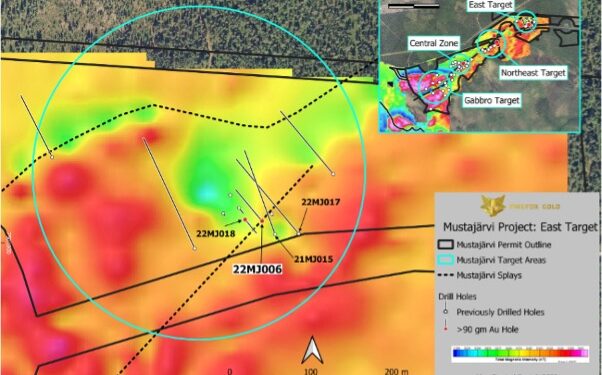FireFox Gold Corp. (TSXV:FFOX) has undertaken additional analyses from the recent drill programme at the company’s 100%-held Mustajärvi Gold Project in Lapland, Finland.
The company previously reported its best drill intercept yet from Mustajärvi, a 13.85-metre interval of drill hole 22MJ006 that averaged 14.39 g/t gold beginning only 24.2m down hole.
A subsequent programme of screen fire assays of the highly mineralized interval confirmed that the mineralisation is remarkably consistent, but the tests also identified coarse gold in one of the samples.
Highlights:
- One sample from 25.05 to 26.00 metres depth returned a total gold grade of 439 g/t
- This sample contained 423 milligrams of coarse gold
- This bonanza grade sample was part of a field duplicate pair:
- The duplicate twin contained total gold of 15.85 g/t
- If all the screen fire results were incorporated into the broader high-grade interval, it would average 28.74 g/t over 13.85 metres
- Most of the interval exhibited excellent consistency between original fire assay and screen fire assays
- FireFox is working with its consultants and service providers to better understand and characterise the coarse gold at Mustajärvi
“The high-grade gold at Mustajärvi comes with its own special challenges, but the team has done an excellent job implementing a rigorous quality assurance protocol. These screen fire assay results remind us that this system contains significant coarse gold, and any noteworthy drill intercept may contain more gold than we first estimate,” commented CEO, Carl Löfberg, said.
“The gold system in the East Target comes right to surface and we see evidence for more than one direction of structural control. We look forward to bringing the drill back to follow-up, as these shallow intercepts are open in several directions.”
FireFox maintains an ongoing quality assurance program that includes screen fire gold assays on the high-grade intervals encountered at Mustajärvi. In this case, the team selected eight samples from the 13.85-metre interval for screen fire gold assay. These samples all contained more than 10 g/t gold, as reported from an initial 50-gram fire assay and confirmed by triplicate 50-gram gravimetric “overlimit” fire assays.
As an additional component of its quality assurance programme, FireFox designates approximately 3% of drilling samples as field duplicates. One of the field duplicates fell within this highly mineralised interval. In this instance, the other half of the sawed core is submitted blindly to the lab as a check of the total variability of gold, including that caused by the geological sample medium plus sample preparation and analysis. This resulted in the entire drill core being processed for the 0.95-metre interval in question. Hence, the discovery that this interval contained a coarse gold fragment (a “nugget”).
Native gold tends to be malleable, which means it may not be ground or reduced in size when subjected to pulverising in a standard lab preparation procedure. The screen fire assay procedure evaluates this component of unpulverised material for gold by passing the entire 1,000-gram sample through a 106-micron (Tyler 150 mesh) screen. Gold and other material that has not been sufficiently pulverized will be retained on the screen, then this entire “plus fraction” is fire assayed, reporting the contained gold in milligrams.
During the screen fire process, the assayers determined that there were 423 milligrams of coarse gold in the sample, a significant part of the 23.2 grams of material collected in the plus fraction. Interestingly, the fine fraction of material, which did pass through the screen, assayed consistently around 16 g/t gold. The weighted average of the gold in the fine fraction plus the gold in the coarse fraction results in a calculated total gold value of the sample of 439 g/t.
For further information please visit: https://www.firefoxgold.com/












